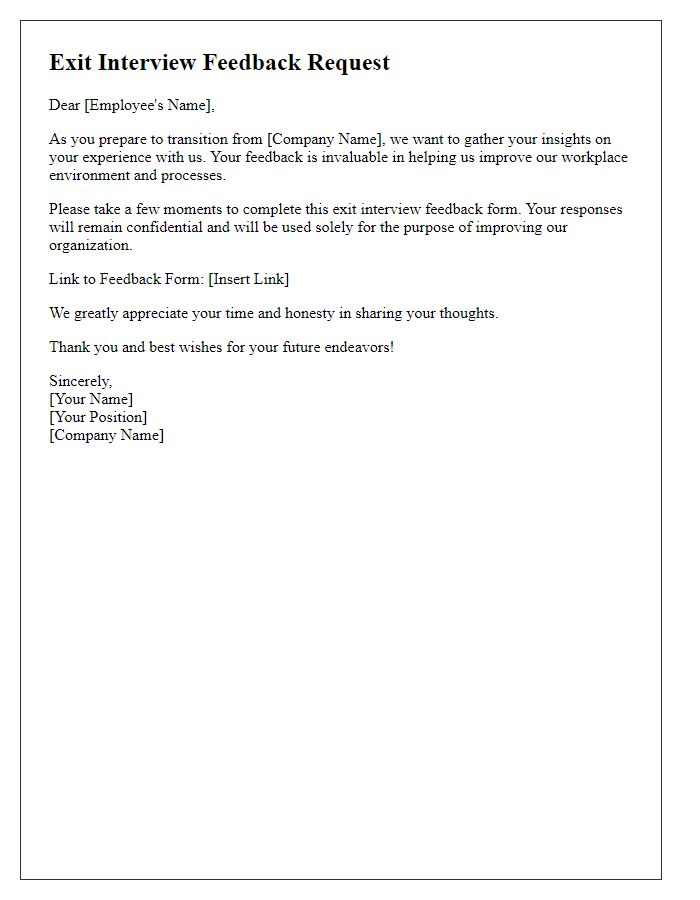When an employee departs from a company, conducting an exit interview is an essential step in understanding their experience and gathering valuable insights. This conversation not only helps the organization improve retention strategies but also provides a platform for the departing employee to share their thoughts. By discussing their reasons for leaving and any suggestions for improvement, companies can foster a positive workplace culture moving forward. Curious to explore how to effectively structure your exit interview process? Read on!

Introduction and Purpose
An employee exit interview serves as a crucial tool for organizations, allowing them to gain insights into the experiences of departing employees. This process typically occurs during the final weeks of employment, providing a structured environment for open dialogue. Key objectives include understanding reasons for departure, assessing workplace culture, and identifying areas for improvement within the organization. These interviews not only facilitate valuable feedback but also contribute to enhancing employee retention strategies in the future. Conducted by human resources personnel, exit interviews can provide data on common trends or issues that might need addressing, ultimately fostering a more positive work environment for current and future employees.
Interview Date and Time
The employee exit interview occurs on a designated date and time, allowing the Human Resources department to gather valuable feedback. Scheduled for November 10, 2023, at 2:00 PM, the meeting takes place in the HR conference room located at the company's headquarters in San Francisco, California. This interview aims to discuss the employee's experiences, reasons for leaving, and suggestions for organizational improvement. Key aspects of the discussion include work environment, job satisfaction, and internal processes, all critical for enhancing employee retention strategies.
Confidentiality Assurance
Confidentiality assurance is critical in fostering an open and honest dialogue during employee exit interviews. These discussions, typically conducted by Human Resources professionals in private office settings, aim to gather insights about employee experiences, workplace culture, and reasons for departure. Ensuring that interviews remain confidential encourages departing employees to share valuable feedback without fear of repercussions. HR representatives often emphasize that all comments will remain anonymous and only used for organizational improvement purposes. Building this trust is essential in organizations, especially in industries like technology, healthcare, or finance, where retaining employee insights can significantly shape workforce strategies.
Topics of Discussion
An employee exit interview serves as a valuable opportunity for both the departing employee and the organization to discuss various topics that can lead to insights and improvements. Key discussion topics include reasons for departure, such as job satisfaction, work environment, management effectiveness, and team dynamics. Additionally, exploring career growth opportunities, compensation perceptions, and benefits utilization can shed light on company policies and culture. It is important to also address the onboarding experience, training adequacy, and resources provided during employment. Feedback on workplace communication, conflict resolution practices, and overall organizational structure can further enhance understanding of employee experiences. Finally, collecting thoughts on the transition process, knowledge transfer, and recommendations for improvement can aid in retaining current talent and attracting future employees.
Contact Information for Follow-up
Providing accurate contact information is critical during employee exit interviews. This ensures that follow-up communications regarding benefits, final paychecks, and references can be seamless. Essential details may include the employee's personal email address (for ongoing correspondence), phone number (for any urgent queries), and LinkedIn profile (for professional networking). It is also beneficial to note the best times for follow-up conversations, as well as any preferred communication methods. Collecting this information helps maintain a professional relationship and facilitates any necessary clarifications or transitions related to the employment departure.













Comments